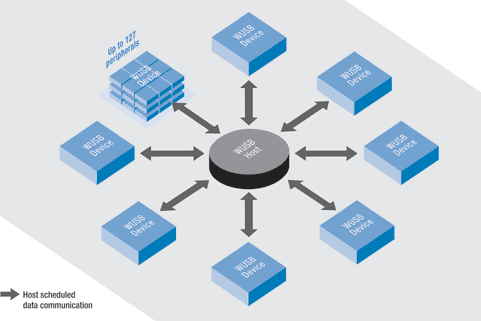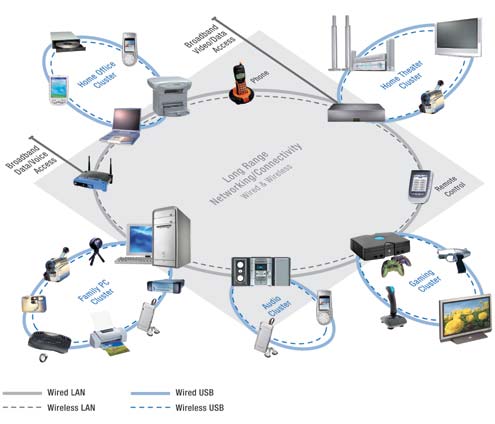|
|
| An introduction to Wireless USB (WUSB) |
by Rafael Kolic (Feb. 21, 2004)
Foreword:
This technical whitepaper by Rafael Kolic, a technology marketing
manager in Intel's Corporate Technology Group, introduces Wireless USB
(WUSB) and explains how it will impact device performance and mobility.
The latest iteration of USB technology, WUSB will offer the same
functionality as standard wired USB devices -- but without the cabling.
Wireless USB Brings Greater Convenience and Mobility to Devices
by Rafael Kolic
Overview: Unwiring USB
Imagine
if all the devices in a home office -- such as printer, scanner,
external hard drive, and digital camera -- could be connected to your
PC without any wires. Imagine if all the components for an entire home
entertainment center could be set up and connected without a single
wire. Imagine if digital pictures could be transferred to a photo print
kiosk for instant printing without the need for a cable. These are just
some of the possible scenarios for high-speed wireless USB (WUSB)
connectivity, the latest technology developed to bring even greater
convenience and mobility to devices.
Universal serial bus
(USB) technology has been a popular connection type for PCs and it's
migrating into consumer electronic (CE) and mobile devices. Now this
high-speed and effective connection interface is unwiring to provide
the functionality of wired USB without the burden of cables. This next
iteration of USB technology is the focus of the new Wireless USB
Promoter Group, which will define the specifications that will
eventually provide standards for the technology.
Wireless USB Promoter Group
At
the Spring 2004 Intel Developer Forum, formation of the Wireless USB
Promoter Group was announced. The group is comprised of seven industry
leaders: Agere Systems, HP, Intel, Microsoft Corporation, NEC, Philips
Semiconductors and Samsung Electronics.
The Wireless USB
Promoter Group is chartered with defining the wireless USB (WUSB)
specification. Already there has been some progress with the definition
of a WUSB specification with a targeted bandwidth of 480 Mbps. This
specification maintains the same usage and architecture as wired USB
with a high-speed host-to-device connection. With these considerations
in place, it will enable an easy migration path for today's wired USB
solutions.
Additionally, WUSB specifications will be based on
ultra wideband (UWB) radio efforts by the MultiBand OFDM Alliance
(MBOA) and WiMedia Alliance, both open industry associations that
promote personal-area range wireless connectivity and interoperability
among multimedia devices in a networked environment.
WUSB Topology
The fundamental relationship in WUSB is a hub and spoke topology, as shown in Figure 1.
In this topology, the host initiates all the data traffic among the
devices connected to it, allotting time slots and data bandwidth to
each device connected. These relationships are referred to as clusters.
The connections are point-to-point and directed between the WUSB host
and WUSB device.

Figure 1 -- WUSB topology
The
WUSB host can logically connect to a maximum of 127 WUSB devices,
considered an informal WUSB cluster. WUSB clusters coexist within an
overlapping spatial environment with minimum interference, thus
allowing a number of other WUSB clusters to be present within the same
radio cell.
Topology will support a dual role model where a
device can also support limited host capabilities. This model allows
mobile devices to access services with a central host supporting the
services (i.e., printers and viewers). This model also allows a device
to access data outside an existing cluster it may currently be
connected to by creating a second cluster as a limited host.
Additionally,
high spatial capacity in small areas is needed to enable multiple
device access to high bandwidth concurrently. Multiple channel
activities may take place within a given area. The topology will
support multiple clusters in the same area. The number of clusters to
be supported is still being determined.
Design Considerations
There
are several architectural considerations in developing WUSB. In
addition to providing wireless connectivity, WUSB must be backwards
compatible with wired USB and provide a bridge to wired USB devices.
Also, the host and solutions will need to enable the exchange of data
between clusters or devices not related to the same host.
Low-cost
implementation of WUSB will also be important to the successful
integration of the technology. Implementation will follow the wired USB
connectivity models as closely as possible to reduce development time
and to preserve the low-cost, easy-to-use model, which has become
pervasive in the PC industry.
Performance
WUSB
performance at launch will provide adequate bandwidth to meet the
requirements of a typical user experience with wired connections. The
480 Mbps initial target bandwidth of WUSB is comparable to the current
wired USB 2.0 standard. With 480 Mbps being the initial target, WUSB
specifications will allow for generation steps of data throughput as
the ultra wideband radio evolves and with future process technologies,
exceeding limits of 1 Gbps.
The specification is intended for
WUSB to operate as a wire replacement with targeted usage models for
cluster connectivity to the host and device-to-device connectivity at
less than 10 meters. The interface will support quality delivery of
rich digital multimedia formats, including audio and video, and will be
capable of high rate streaming (isochronous transfers).
Radio System Power and Power Management
Radio
system power (power used only by the radio) will be expected to meet
the most stringent requirements where mobile and handheld battery life
is important. For example, typical PDAs use 250–400 mW without a radio
connection, while typical cellular phones use 200 mW–300 mW with the
primary WAN radio. Adding a WUSB radio should not increase power
requirements any more than existing wireless technologies already
employed today.
Battery-powered operation requires reasonable
battery life: 2–5 days for highly mobile devices and several months for
intermittently used devices like remote controls. WUSB, based on the MultiBand OFDM Alliance
(MBOA) radio, will strive to meet these standards. The power target for
WUSB radio will be introduced at less than 300 mW and drive to a target
of 100 mW over time.
Dual-Role Devices
A new
class of devices, called WUSB dual-role devices, will give rise to
usage scenarios not previously possible. These devices will offer both
limited host and device capabilities similar to USB On-The-Go.
Usage Applications
With
the growing use of digital media in the PC, consumer electronic (CE)
and mobile communication environments, a common standard interconnect
is needed to support the on-going convergence of these environments.
The trend toward convenient wireless distribution of digital
information provides an opportunity to introduce a single, standard
wireless interconnect capable of supporting usage models across all
three environments.
The CE environment will have high-performance wireless interface expectations. Consumer usage models (Figure 2)
will center on streaming media distribution that typically uses
compression algorithms. The performance objective is to ensure a high
quality of service is maintained to meet typical consumer entertainment
expectations.

Figure 2 -- Consumer Usage Models
Typical
video delivery with standard SDTV/DVD will consume between 3 and 7 Mbps
while HDTV will use between 19 and 24 Mbps. A point distribution
technology like wireless USB with an effective bandwidth of 480 Mbps
could manage multiple HDTV streams. Host buffering could enable a
network backbone to effectively distribute content to all distribution
hosts, enhancing the quality experience for all users.
Business
applications for WUSB include a variety of different usage
possibilities. Common devices such as printers, scanners, hard drives,
and projectors could all be used in wireless scenarios. These devices
would function the same way as if they were using wired USB, but
without all the cables. Office services on the corporate network could
migrate to WUSB and benefit from faster performance than shared network
devices offer.
Security and Device Association
WUSB
security will ensure the same level of security as wired USB.
Connection-level security between devices will ensure that the
appropriate device is associated and authenticated before operation of
the device is permitted. Higher levels of security involving encryption
should be implemented at the application level. Processing overhead
supporting security should not impose noticeable performance impacts or
add device costs.
One of the primary objectives when
implementing a wireless interconnect is that it is easy to install and
use. Wired connections provide the user with implied expectations, that
is that the device is connected as specified by the user when they
install the wire. When the wire is installed, the user has basic
expectations and when these expectations do not take place (plug does
not fit), there is a known recourse.
Wireless connections, on
the other hand, due to environmental characteristics, may establish
connection paths that are not obvious. In fact, it may not be obvious
when a device is connected.
So WUSB devices installed for the
first time should automatically install drivers, security features, and
so on and associate with systems that they can interact with. The
concepts of 'turn on and use it' with an easy setup procedure will be
employed.
WUSB in the Future
The first Wireless
USB implementations will likely be in the form of discrete silicon that
will be introduced in a number of form factors. These may include
add-in cards and dongles along with embedded solutions to support the
technology's introduction and subsequent rapid ramp up.
But
the wireless future will arrive once WUSB, along with the common ultra
wideband platform, becomes a standard part of every processor and
chipset and is integrated in CMOS silicon.
Summary
As
the latest iteration of USB technology, wireless USB (WUSB) will offer
the same functionality as standard wired USB devices but without the
cabling. As the new Wireless USB Promoter Group prepares to develop the
specifications that will help standardize the technology, the industry
is planning products that can take advantage of the convenience and
mobility that this new device interconnect will offer.
More Info
 About the author:
Rafael Kolic is a technology marketing manager in the Communications
Technology Lab, part of Intel's Corporate Technology Group. Since
joining Intel in 2000, he has worked on a number of projects involving
ultra wideband, wireless USB, USB 2.0, UPnP, and several other
technologies. Kolic has also performed research in the area of power
electronics. He holds an M.E. in electrical and computer engineering
and a B.S. in electrical engineering from the University of Florida. About the author:
Rafael Kolic is a technology marketing manager in the Communications
Technology Lab, part of Intel's Corporate Technology Group. Since
joining Intel in 2000, he has worked on a number of projects involving
ultra wideband, wireless USB, USB 2.0, UPnP, and several other
technologies. Kolic has also performed research in the area of power
electronics. He holds an M.E. in electrical and computer engineering
and a B.S. in electrical engineering from the University of Florida.
Copyright
© Intel Corporation 2003-2004. All rights reserved. Reproduced by
DeviceForge.com with permission. This article was originally published
in Intel's Technology@Intel Magazine.
 |
|
|
|
|
|
|
|

 Use of this site is governed by our Terms of Use
and Privacy Policy.
Except where otherwise specified, the contents of this site are copyright
© 2003-2005 Ziff Davis
Publishing Holdings Inc. All Rights Reserved.
Reproduction in whole or in part without permission is prohibited.
Use of this site is governed by our Terms of Use
and Privacy Policy.
Except where otherwise specified, the contents of this site are copyright
© 2003-2005 Ziff Davis
Publishing Holdings Inc. All Rights Reserved.
Reproduction in whole or in part without permission is prohibited.